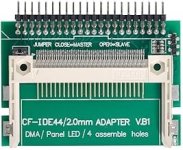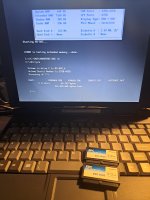Nice to see you got DOS running. Maybe add Win 3 next?
I agree that 1/2 GB would be limiting unless just using DOS. Two to four GB is a lot better if running Windows 95/98/ME and plenty big unless you load a bunch of games or office programs. I would suggest that having a PCMCIA card that uses a second CF or SD card to expand storage is also very doable.
I opp'ed for that somewhat larger capacity of 2GB for the primary drive size since some time ago I lucked into an auction lot of 2GB CF cards for very little money each. I've loaded various OS's (DOS, FreeDOS, Win 95, Win98, WinME, Win2K and a couple types of Llinux) onto them so that I can swap them in and out for testing. Ialso use a few more up to 4GB for use with a PCMCIA card to load utilities etc. While I do have 8 and 16GB CF's that I use with other laptops that can use up to 32GB drives. I also have a lot of 8GB and larger spinning drives I kept from my laptop business days.
Prices on old PATA spinning drives in smaller sizes compared to a CF or SD cards, even with the cost of the adapter, just doesn't make much sense unless going for the complete retro feel including head clunks and bearing noises is key.



